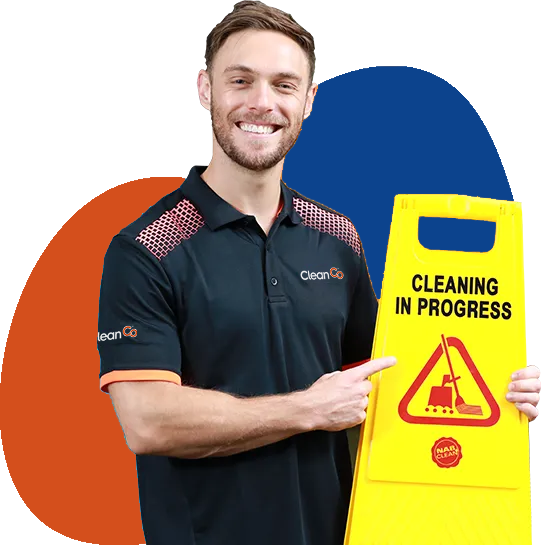An organised, clean office isn’t just about aesthetics; it plays a significant role in the overall productivity, morale, and well-being of your team. Regular office cleaning visits ensure your workspace remains fresh, but it’s equally important to maintain cleanliness between these visits. By following a few simple habits and routines, you can keep your office looking tidy, healthy, and professional, helping to maintain a productive environment for all.
In this post, we’ll walk you through 15 essential office cleaning tips that you and your team can easily follow to maintain cleanliness and hygiene between professional cleaning visits.
Office Cleaning Tips: Quick Daily Habits
| Tip | Description |
|---|---|
| Declutter Desks Daily | Keep workspaces tidy by clearing papers and organizing files at the end of each day to reduce stress and improve focus. |
| Clean High-Touch Items | Regularly disinfect keyboards, phones, doorknobs, and shared equipment to prevent the spread of germs. |
| Empty Bins Frequently | Prevent bad smells and pests by ensuring trash bins are emptied daily, especially in shared spaces. |
| Maintain Floors and Surfaces | Vacuum, sweep, and dust weekly (or more often in high-traffic areas) to keep allergens and dirt at bay. |
| Keep Shared Areas Hygienic | Disinfect kitchens, restrooms, and meeting rooms daily to ensure a clean, welcoming environment. |
| Stock and Use Cleaning Supplies | Make cleaning tools easily accessible so employees can quickly wipe spills and surfaces as needed. |
| Create a Cleaning Schedule | Assign light cleaning duties to team members on a rotating basis to maintain cleanliness between professional visits. |
1. Declutter Your Desk
A cluttered desk can be a major distraction, not only affecting productivity but also making your workspace look untidy. It’s easy for papers, stationery, and personal items to pile up, but keeping your desk organised is key to maintaining a clean and professional environment.
Tip: Set aside a few minutes at the end of each day to tidy up your desk. Clear away unnecessary papers, pens, and personal belongings, and organise your files into neat stacks or storage containers. This simple routine can help reduce stress, boost focus, and maintain a clean work area.
Example: Think of how much better you feel when you come into a neat and tidy workspace. A clean desk promotes mental clarity and allows you to start your day on the right foot.
2.Clean Your Computer and Keyboard
Your computer, keyboard, and mouse can harbour a surprising amount of dirt, dust, and germs. These surfaces are frequently touched, and over time, they can accumulate grime, which not only looks unsightly but can affect the performance of your devices.
Tip: Use disinfectant wipes or a soft cloth with a mixture of water and mild soap to clean your computer screen, keyboard, and mouse at least once a week. Be gentle with the keyboard to avoid damaging the keys.
Example: Regularly cleaning your keyboard is particularly important if you’re sharing it with colleagues or using it during flu season. A clean device can help reduce the spread of germs.
3.Wipe Down High-Touch Surfaces Regularly
In an office environment, high-touch surfaces like doorknobs, light switches, and shared equipment can be hotspots for germs and bacteria. These areas are frequently touched by many people throughout the day and can become breeding grounds for illnesses.
Tip: Disinfect high-touch surfaces regularly, ideally once a day or whenever they look visibly dirty. A quick wipe with disinfectant wipes or a spray cleaner can help keep these areas free from germs.
Example: Think about the door handle that everyone touches when entering the office. A simple wipe-down at the start or end of the day helps maintain a healthier environment for everyone.
4.Keep Office Trash Bins Empty
An overflowing trash bin is more than just an eyesore—it can attract pests, create unpleasant odours, and contribute to an unhygienic office environment. Ensuring that bins are emptied regularly is an essential part of keeping the office clean and fresh.
Tip: Encourage employees to take responsibility for emptying their own bins at the end of the day. Set up a regular schedule for more significant office-wide bin emptying to ensure the space stays clean.
Example: Emptying bins regularly ensures that there’s never a build-up of waste. It can also reduce the risk of unpleasant smells and makes the office a more welcoming place to work.
5.Sanitize Your Phones and Headsets
Phones, headsets, and other communication devices are shared by many people throughout the day and are prime carriers of germs. These devices are frequently in close contact with your hands, face, and mouth, so keeping them clean is crucial.
Tip: Wipe down your phone and headset with disinfectant wipes regularly, especially if they’re shared by colleagues. Make sure to clean around buttons and screens for thorough sanitisation.
Example: When working in a shared space, sanitising phones after every use can significantly reduce the spread of germs, making it easier to stay healthy.
6.Vacuum or Sweep Frequently
Dust and dirt accumulate on floors quickly, especially in high-traffic areas. Regular vacuuming or sweeping can help maintain a cleaner office, reduce allergens, and contribute to a healthier workspace.
Tip: Vacuum high-traffic areas at least once a week, and more frequently in areas like hallways and near entrances. Sweep floors daily if possible, especially in spaces where dirt tends to build up.
Example: You’d be surprised at how much dust can accumulate on the floor in just one week. Keeping your floors clean helps prevent allergens from building up, creating a more comfortable environment.
7.Dust Shelves, Furniture, and Fixtures
Dust can easily accumulate on shelves, furniture, and light fixtures, creating a layer of grime that makes your office feel untidy and uncomfortable. Dusting regularly helps improve air quality and prevents dust from settling on surfaces.
Tip: Dust shelves, desks, and light fixtures at least once a week. Don’t forget to wipe down lamps, ceiling fans, and air vents, as these areas often collect dust.
Example: Regular dusting improves the appearance of your office and helps those with allergies breathe easier by reducing airborne particles.
8.Maintain Clean Restrooms
A clean and well-maintained restroom is vital for employee comfort and hygiene. Dirty restrooms can create an unpleasant work environment, affecting morale and productivity.
Tip: Regularly inspect restrooms to ensure they are well-stocked with toilet paper, soap, and paper towels. Clean sinks, taps, and mirrors daily to maintain a hygienic atmosphere.
Example: No one wants to use a messy bathroom during their break. Ensuring clean restrooms shows employees that you care about their comfort and health.
9.Disinfect Shared Spaces
Shared spaces like conference rooms, kitchens, and break rooms need extra attention because they’re used by multiple people throughout the day. These areas can easily accumulate crumbs, spills, and germs.
Tip: After meetings or lunchtime, ensure that everyone wipes down tables, chairs, and shared equipment. Disinfect these areas daily to prevent the spread of germs.
Example: After a meeting, a quick wipe-down of the table and chairs can help prevent germs from spreading and keep the space clean for the next group.
10.Use Air Fresheners for a Pleasant Atmosphere
A clean office isn’t just about what you can see—it’s also about what you can smell. A pleasant fragrance can make a significant difference in the office atmosphere, making it more inviting and comfortable.
Tip: Use air fresheners, diffusers, or essential oils to maintain a pleasant scent throughout the office. Choose subtle scents like lavender, citrus, or eucalyptus to avoid overpowering the room.
Example: Fresh-smelling air creates a welcoming environment and can even improve mood, leading to increased productivity.
More Post: How Clean Co Supports Southern Sydney Offices
11.Maintain a Clean Kitchenette
If your office has a kitchenette or communal kitchen area, it’s essential to keep it tidy. This space is often used for meal preparation, and spills or crumbs can quickly make it look messy.
Tip: Clean countertops and appliances daily. Encourage employees to clean up after themselves, wiping down surfaces and washing dishes promptly after use.
Example: A clean kitchenette can make lunch breaks more enjoyable and encourage employees to respect shared spaces.
12.Organize Your Filing System
Piles of paper can quickly become a cluttered mess in the office. A disorganised filing system not only contributes to office clutter but also wastes time when searching for important documents.
Tip: Create a filing system that’s easy to maintain, whether it’s physical or digital. Ensure that documents are sorted and labelled properly, and encourage employees to stay on top of organising their files.
Example: An organised filing system ensures you don’t waste time looking for important documents and keeps your office looking neat and efficient.
13.Clean Your Windows and Glass Surfaces
Dirty windows and glass surfaces can make your office feel dark and uninviting. Clean windows allow more natural light into the workspace and contribute to a brighter, more cheerful environment.
Tip: Clean windows at least once a month using a streak-free glass cleaner. Don’t forget about glass partitions or doors that may need attention too.
Example: Regularly cleaned windows help maximise natural light, which can improve mood and energy levels in the office.
14.Invest in Cleaning Supplies for Easy Access
Having cleaning supplies readily available makes it much easier to maintain cleanliness in the office. If employees can easily grab wipes or sprays, they are more likely to keep their workspaces tidy.
Tip: Stock up on essential cleaning supplies like disinfectant wipes, multi-surface cleaner, and paper towels. Store them in accessible locations around the office, such as the kitchen or near high-traffic areas.
Example: When cleaning supplies are within reach, employees are more likely to take a few moments to clean up spills or wipe down surfaces throughout the day.
More Post: Checklist for Hiring a Commercial Cleaning Service
15.Create a Cleaning Schedule for Employees
A cleaning schedule ensures that everyone in the office is responsible for maintaining cleanliness. It helps prevent cleaning duties from piling up and encourages teamwork.
Tip: Develop a weekly or monthly cleaning schedule, assigning specific tasks to employees. This could include wiping down common areas, emptying bins, or organising filing cabinets.
Example: A shared cleaning responsibility ensures that the workload is spread evenly, making the task feel less overwhelming for anyone.
Conclusion
By following these 15 simple office cleaning tips, you can keep your workspace organised and hygienic between professional cleaning visits. Maintaining a clean office not only boosts productivity and health but also helps to create a positive work environment. Encourage your team to embrace these tips and share them with others to keep your office looking fresh, clean, and welcoming.
Remember, a little effort each day can make a huge difference in maintaining a clean and healthy office environment.


